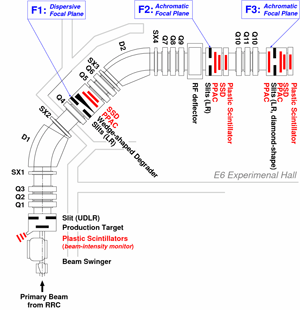| Facility Information |
| User Guide |
| PAC |
| Beam Time Operation |
| RIBF User Group |
| Collaboration |
| Seminars |
| Links |
| Archives |
|
RIPS
 |
||||
Concept
Design concept
 |
Being one of the second-generation separators, which acquire an upgraded performance so as to enhance the scope of RI beaem experiments, RIPS has been designed to achieved two features; 1) strong beam intensity and 2) spin-polarized RI beam.
The first feature is critical to facilitate secondary reaction experiments with RI beams. A lot of structure information and astrophysical information can be obtained through a variety of direct reactions such as elastic and inelastic scattering,transfer and exchange reactions, and Coulomb excitation. These reactions have cross sections ranging from a few mb to a few hundred mb, which can be investigate only with intense secondary beams. This requirement is achieved by having a large solid angle, large momentum acceptance and large bending power.
The second feature, polarized RI beam, has been obtained by utilizing beam swinger equipped just upstream of the production target. Spin-oriented RI beams would signifcantly extend the potential of the RI beams providing the means to explore the spin-related phenomena, such as nuclear moments, fundamental physics, as well as condenced matter physics.
Separation principle
RIPS is a doube achromatic spectrometer with an intermediate dispersive focus between two dipoles that bend in the same direction, which enables us to separate RI beams based on the Br-energy loss method. Projectile-fragments produced by the collision of a heavy ion beam and a production target is first analyzed by their magnetic rigidity Br, which is used to select the fragment of interest according to the A/Z ratio at the first dispersive focus (F1). A wedge-shaped energy degrader is placed at F1 to induce dispersion due to energy loss. Because the energy losses of different isotopes are different, isotopes of interest can be further separated from the nuclei with the same A/Z ratio by the second section. The produced RI beams are transported to the third focus, where a secondary target or a stopper is placed for radioactive-beam experiments.
In order to achieve upgraded beam intensities, the RIPS has been designed to have wide acceptance and large magnetic rigidity. The values of acceptance are taken to be 80 mrad (circle) for angle and 6% for momentum. At beam energies around 100A MeV, the emission angle and momuntum of fragments have relatively large spread because of relatively poor kinematic focusing. The spread is particularly large when a light projectile is used and fragments to be collected are far deviated from the projectile. The wide acceptance was chosen so as to match up such situations. For instance, the adopted values nearly amount to the angular and momentum widths of 11Li fragments, which are produced in the projectile fragmentation of 18O at 100A MeV. In practice a thick target is used to optimize the net secondary-beam intensity, where the momentum width of fragments is fairly widened. Under this condition, about 12% of the reaction product is to be transmitted for 11Li. Better collection efficiencies up to 60% may be obtained for fragments closer to the projectile.
